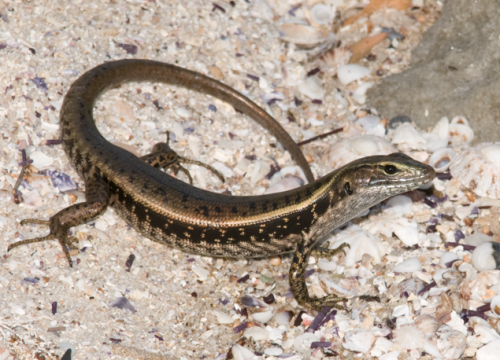An Eastern Water Skink (Eulamprus quoyii). Credit: Martin Whiting
(Phys.org) —New collaborative research conducted by Macquarie University and the Australian National University on a common Australian lizard, the Eastern Water Skink, has revealed that sexual selection, the process whereby certain individuals gain a reproductive advantage, likely promotes the evolution of 'floater' and 'territorial' behavioural reproductive tactics in males.
The researchers studied six marked populations of the Eastern Water Skink in large naturalistic outdoor enclosures. They followed the movements and behaviour of males during the breeding season, and used genetic paternity testing to determine reproductive fitness.
"Ultimately, we were interested in what behavioural traits make a successful male lizard" said lead researcher Daniel Noble.
"As it turns out, large males that adopt either a territorial-like tactic (where they defend a fixed area), or a 'floater' or 'sneaker'- like tactic (with no defense of a particular space, but who move over a wider area), father the most offspring and therefore have the highest fitness."
Alternative reproductive tactics (ARTs) have been studied in a wide range of species. However, few studies document ARTs in species where there are no distinguishing features separating males from each other. This study demonstrates that ARTs can be driven by behaviour alone.
Noble explains "Males adopting ARTs are often distinct from one another in terms of body size, colouration, or the presence and size of armaments such as horns. We know very little about ARTs in nondescript species.
"What makes these results particularly interesting is that we simply quantified behavioural variation to test whether there was evidence of disruptive selection on trait combinations predicted to be associated with ARTs in water skinks.
"In many systems, we cannot take this approach because polymorphic species (that is, males with different coloration) lack intermediate phenotypes. Our results have important implications for understanding the early evolution of ARTs because they suggest selection starts by acting on more labile behavioural traits, which allow males to gain access to mating opportunities through different mechanisms."
The authors have documented a rare case of ARTs evolving through selection on suites of male behaviours. This cryptic system may be more common than currently understood, and underscores the importance of behaviour as an ART in its own right.
The research paper has been published in full online in the American Naturalist.
More information: Daniel, W. et al. Behavioral and Morphological Traits Interact to Promote the Evolution of Alternative Reproductive Tactics in a Lizard (2013), The American Naturalist. www.jstor.org/stable/10.1086/673535
Journal information: American Naturalist
Provided by Macquarie University























